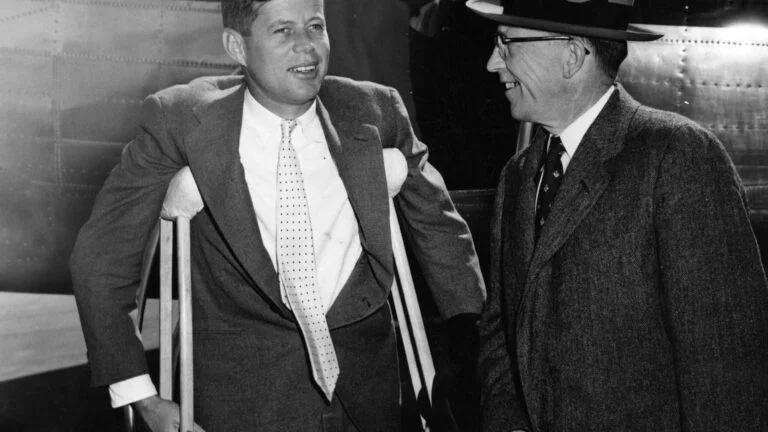Since his days at Harvard in 1937, one of America’s most famous presidents has suffered chronic back pain. John F. Kennedy’s back condition and his four surgeries to treat it. This raises the question of his back pains contributing to his untimely demise.
John F. Kennedy suffered from chronic back pain. He had four back surgeries, including a discectomy, instrumentation, and fusion, and two minor surgeries that did not relieve his pain.
The Chronic Back Pain and Grueling Surgeries
Kennedy visited the Mayo Clinic after returning from the Pacific in 1944. The team at the hospital determined that Kennedy’s pain was not an obvious manifestation of a herniated disc and did not recommend surgery. Kennedy went ahead with two surgeries anyway in June of that year. First, an L4-5 laminotomy was performed, followed by an L5-S1 discectomy. The surgeries were a failure, and Kennedy later wrote:
In regard to the fascinating subject of my operation. I think the doc should have read just one more book before picking up the saw.
President John F. Kennedy
Before his next procedure, a lumbosacral fusion, in 1954, Kennedy served in the House of Representatives and then the Senate. Complications following surgery meant additional months of recovery. Kennedy had become ill with an infection. Later, a friend who visited him during his recovery wrote :
The area where they cut into his back never healed. It was oozing blood and pus all the time. It must have been painful beyond belief. It was an open wound that seemed to be infected all the time. And now and then, a piece of bone would come out of the wound. His pain was excruciating.
John F. Kennedy’s Friend
The fusion hardware was removed in February 1955, just a few months before Kennedy’s return to the Senate. Kennedy continued to treat him with an internal medicine specialist, likely with trigger-point injections and the introduction of a rocking chair. Kennedy had his final back surgery in 1957 to treat an abscess that had formed near his incision.
Dr. Pait believes that Kennedy eventually developed discogenic disease due to a childhood injury that set off a chain reaction of problems. The Mayo Clinic and the Lahey Clinic both advised against surgery.
Much like what we see today, Kennedy told his physicians that he could not live with the pain. With further insistence from his father, Joseph P. Kennedy Sr, the neurosurgeon at the Lahey Clinic, decided to go forward with surgery, which consisted of a left L4–L5 laminotomy and L5–S1 discectomy. The surgery was a failure, which prompted further evaluation.
Dr. Glenn Pait, MD, Director of the Jackson T. Stephens Spine and Neurosciences Institute at the University of Arkansas for Medical Sciences.
(Source: Spine Universe)
The Back Brace Theory
In addition to surgery, he was given trigger point injections and a physical therapy program, swimming and weight lifting, massage and a back brace, narcotics, and methamphetamine-containing shots by Max Jacobson, MD, also known as Dr. Feelgood.
Physical therapy scheduled three times per week of weight lifting and almost daily swimming improved significantly. Kennedy’s doctor attempted to wean him off his long-term reliance on a corset-type brace.
According to Dr. Pait, Kennedy’s reliance on his back brace may have contributed to his death, as he wore his brace while also wrapping his trunk in an Ace bandage. When the first fatal shot to the head was fired in Dallas, Kennedy’s tightly bound lumbar brace appears to have caused him to return to an upright position rather than crumpling forward, allowing Kennedy to return to the line of fire for the second fatal shot to the head. (Source: Spine Universe)
Image from Boston
